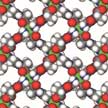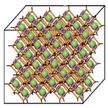Showing Spotlights 25 - 27 of 27 in category All (newest first):
 With their special structure and large surface area, MOFs open up new opportunities in drug delivery. The ability to exchange the metal centers and organic linkers even provide an extensive library of MOF materials. As a result, the integration of small guest molecules within the MOF pores, such as small molecule drugs and biomolecules, have shown promise for delivery applications to treat diseases. A recent review article discusses current proceedings on integrating diverse biomolecules within MOFs.
With their special structure and large surface area, MOFs open up new opportunities in drug delivery. The ability to exchange the metal centers and organic linkers even provide an extensive library of MOF materials. As a result, the integration of small guest molecules within the MOF pores, such as small molecule drugs and biomolecules, have shown promise for delivery applications to treat diseases. A recent review article discusses current proceedings on integrating diverse biomolecules within MOFs.
Jul 4th, 2017
 Metal-organic frameworks (MOFs) are well-ordered, lattice-like crystals. The nodes of the lattices are metals, which are connected by organic molecules. The most impressive features of MOFs are their extremely high surface area, high porosity, and tunable pore sizes, which are remarkable advantages over other porous materials (e.g., zeolites and carbons). With their special structure and large surface area, MOFs open up new opportunities for alternative systems for gas and energy storage (e.g. carbon dioxide and hydrogen storage), in catalysis, chemical sensing, as nanoreactors, and in drug delivery, making them hugely interesting for both university research and industry.
Metal-organic frameworks (MOFs) are well-ordered, lattice-like crystals. The nodes of the lattices are metals, which are connected by organic molecules. The most impressive features of MOFs are their extremely high surface area, high porosity, and tunable pore sizes, which are remarkable advantages over other porous materials (e.g., zeolites and carbons). With their special structure and large surface area, MOFs open up new opportunities for alternative systems for gas and energy storage (e.g. carbon dioxide and hydrogen storage), in catalysis, chemical sensing, as nanoreactors, and in drug delivery, making them hugely interesting for both university research and industry.
Jun 15th, 2017
 Metal-organic frameworks (MOFs) are regarded as a new class of porous materials with significant prospects for addressing current challenges pertinent to energy and environmental sustainability. Due to their unique structure design and tunability, MOFs offer great potential for their effective integration and exploration in various sensing applications. Researchers have demonstrated this by developing an advanced sensor for the detection of hydrogen sulfide at room temperature, using thin films of rare-earth metal based MOF.
Metal-organic frameworks (MOFs) are regarded as a new class of porous materials with significant prospects for addressing current challenges pertinent to energy and environmental sustainability. Due to their unique structure design and tunability, MOFs offer great potential for their effective integration and exploration in various sensing applications. Researchers have demonstrated this by developing an advanced sensor for the detection of hydrogen sulfide at room temperature, using thin films of rare-earth metal based MOF.
Feb 10th, 2017
 With their special structure and large surface area, MOFs open up new opportunities in drug delivery. The ability to exchange the metal centers and organic linkers even provide an extensive library of MOF materials. As a result, the integration of small guest molecules within the MOF pores, such as small molecule drugs and biomolecules, have shown promise for delivery applications to treat diseases. A recent review article discusses current proceedings on integrating diverse biomolecules within MOFs.
With their special structure and large surface area, MOFs open up new opportunities in drug delivery. The ability to exchange the metal centers and organic linkers even provide an extensive library of MOF materials. As a result, the integration of small guest molecules within the MOF pores, such as small molecule drugs and biomolecules, have shown promise for delivery applications to treat diseases. A recent review article discusses current proceedings on integrating diverse biomolecules within MOFs.
 Subscribe to our Nanotechnology Spotlight feed
Subscribe to our Nanotechnology Spotlight feed
